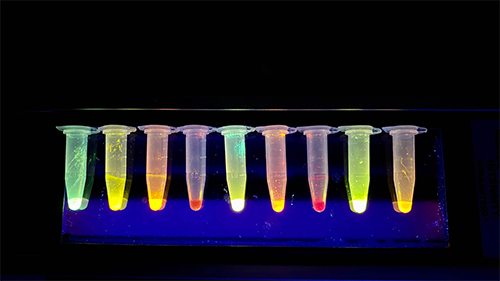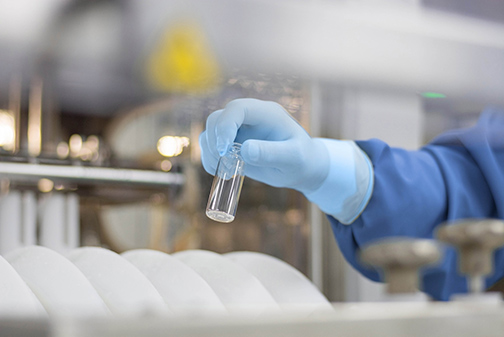Solutions
In cutting-edge fields such as modern bioscience, medical research, materials science, environmental monitoring, and molecular diagnostics, fluorescent dyes and fluorescent probes are driving technological breakthroughs at an unprecedented pace. As a global leader in chemicals and life science solutions, BOC Sciences leverages its robust technological platform and customization capabilities to provide a comprehensive range of high-performance, versatile fluorescent dyes and probe products and services for scientific researchers and industrial clients worldwide. We are committed to offering customized, standardized, and systematized solutions to meet diverse needs from basic research to clinical development, helping our clients advance steadily in scientific exploration and technological transformation.
Why are Fluorescent Dyes and Probes So Important?

Fluorescent dyes and fluorescent probes, as core tools in modern molecular detection and visual analysis, are continuously propelling innovation in areas such as biological research, medical diagnostics, drug screening, and materials science. By specifically binding to target molecules and emitting controllable fluorescent signals, they enable highly sensitive, real-time, and quantitative monitoring of complex biological systems. Their importance is mainly reflected in the following aspects:
- High Sensitivity Detection: Fluorescent signals offer extremely high sensitivity, enabling the detection of target molecules at very low concentrations, which is critical for trace analysis and single-molecule detection.
- Real-Time Visualization and Tracking: Utilizing fluorescence microscopy or high-throughput imaging systems, researchers can dynamically monitor the localization, expression, and interactions of molecules within cells, organs, or organisms.
- Multiplexing Capability: The combined use of multicolor fluorescent dyes allows simultaneous detection of multiple targets, widely applied in various experimental techniques such as flow cytometry, multiplex PCR, and immunohistochemistry.
- Specific Recognition: Through precisely designed fluorescent probes, specific DNA/RNA sequences, proteins, or small molecules can be identified, significantly improving experimental specificity and accuracy.
Advantages of BOC Sciences in Fluorescent Dyes and Probes
Extensive Product Line and Structural Diversity
We offer hundreds of fluorescent dye and probe products, covering mainstream types such as organic dyes, fluoresceins, rhodamines, BODIPY, and the Cyanine series. These products support fluorescence needs across various wavelengths (from UV to near-infrared), making them compatible with a wide range of platforms.Highly Customized Service Capabilities
BOC Sciences provides one-stop custom services ranging from molecular structure optimization, spectral performance screening, linker design, to targeting group modification. We flexibly respond to scientific and industrial clients' personalized needs regarding spectral properties, stability, water solubility, pH sensitivity, and more.International Standard Quality Control System
We have established a comprehensive quality evaluation process, including purity testing, spectral performance testing (UV-Vis, Fluorescence), and stability analysis, ensuring consistent performance and reliability in every batch of fluorescent dyes and probes, in compliance with GMP and ISO certification requirements.Application-Oriented Technical Support System
BOC Sciences not only offers products but also full-process technical support, including experimental design consultation, probe construction recommendations, optimization of validation protocols, and data analysis guidance, helping clients save time and improve efficiency in complex experimental workflows.
Customized Solutions for Fluorescent Dyes and Probes
BOC Sciences has established a comprehensive and functionally diverse system of fluorescent dye and probe products, covering multiple categories from conventional labeling dyes to highly sensitive probe molecules, meeting the needs of life sciences, materials research, drug development, and other fields. Our products include classic organic dyes (such as FITC, Rhodamine, Cy series, Alexa Fluor), near-infrared dyes, quantum dots, and fluorescent nanomaterials, as well as molecular probes with targeting capabilities, such as ion-responsive probes (Ca²⁺, Zn²⁺, Cu²⁺), pH-sensitive probes, and reactive oxygen species probes (ROS/RNS). To accommodate various labeling needs, BOC Sciences also provides a variety of functionalized dyes (e.g., NHS esters, Maleimide, Azide), which can be covalently linked to biological molecules such as proteins, nucleic acids, and antibodies. With a rich structural library and flexible modification capabilities, BOC Sciences offers both standard off-the-shelf products and highly customized fluorescent molecular solutions for the following applications:
Life Science and Biomedical Research
- In Vivo Imaging
- Bacteria Imaging
- Cell Imaging
- Fluorescence Imaging
- Molecular Imaging
- Ion Imaging
- Flow Cytometry
- Fluorescent ELISA
- Fluorescence Microscopy
- Gel Electrophoresis
- Carbohydrate Staining
- Cell Staining
- Enzyme Staining
- Lipid Staining
- Nucleic Acid Staining
- DNA Staining
- RNA Staining
- Protein Staining
Clinical Diagnostics
- Quantitative Real-Time PCR (qPCR)
- Fluorescence In Situ Hybridization (FISH)
- Immunofluorescence Staining
- Fluorescence Immunoassay (FIA)
- Microarray Analysis
Drug Development
Customized Services for Precision Molecular Recognition and Imaging Platforms
With the increasing refinement of research in molecular imaging and precision detection, standardized fluorescent dyes and probe products can no longer fully meet the complex and variable demands of scientific research and practical applications. Leveraging its profound capabilities in organic synthesis, molecular modification technologies, and interdisciplinary R&D resources, BOC Sciences has established a systematic and modular custom service system. This platform supports the full-process development from molecular structure design, fluorophore selection, linker strategy optimization to bio-compatibility evaluation. Whether for target-specific recognition, signal amplification mechanism construction, or multi-channel imaging and high-throughput detection platform development, BOC Sciences offers highly personalized solutions. These services help clients develop molecular probe tools truly adapted to their research scenarios, accelerating scientific breakthroughs and industrial transformation.
Customized Dye and Probe Molecular Structures
- Tuning of fluorescence emission wavelengths (UV-VIS-NIR);
- Optimization of photostability and water solubility;
- Functional group modification to suit customer system requirements;
- Covalent conjugation or non-covalent binding of targeting ligands (e.g., antibodies, peptides).
Dye-Biomolecule Conjugation Services
- Labeling of proteins, nucleic acids, oligonucleotides, and nanoparticles with dyes;
- Multi-site or multi-dye labeling for multi-channel imaging;
- Provision of complete labeling protocols and quality control tests (HPLC, MS, UV-Vis).
Scale-Up Production and Quality Control
- Supply of dye or probe products from gram to kilogram scale;
- Compliance with both research-grade and industrial-grade quality standards;
- Support for GMP-grade dye development for preclinical diagnostic reagent applications.
Rigorous Quality Testing Services Provide Reliable Data Support
BOC Sciences places high importance on product quality control and has established a comprehensive quality management system encompassing raw material selection, synthesis processes, optical property validation, and functional application testing. All products undergo strict multi-dimensional testing before release to ensure excellent performance in both research and industrial applications, with good batch-to-batch consistency and long-term storage stability. Whether for standard products or customized probes, all are evaluated according to international quality standards, and detailed testing reports are provided to help customers obtain more efficient and reliable experimental data. Major quality control items include:
- Structure Confirmation: Confirmation of target molecule structure via nuclear magnetic resonance (NMR) and mass spectrometry (MS), preventing experimental interference caused by isomeric impurities or unreacted intermediates.
- Chemical Purity Testing: High-performance liquid chromatography (HPLC) is used to ensure the main component exceeds 95% purity, minimizing background signal interference risks at the source.
- UV-Visible Absorption Spectral Analysis: Detection of maximum absorption wavelength and molar absorptivity to verify optical properties align with design parameters, ensuring optimal fluorescence excitation efficiency.
- Fluorescence Emission Spectrum Testing: Measurement of emission peak positions and intensity distribution to ensure high brightness and low background in the target wavelength range, enhancing imaging clarity.
- Quantum Yield Measurement: Evaluation of photon emission efficiency upon excitation—an essential parameter determining fluorescence capability and directly impacting detection sensitivity.
- Thermal Stability Assessment: High-temperature stress testing under simulated transportation and storage environments to ensure no degradation or performance loss under prolonged or elevated temperature conditions.
- Water Solubility and pH Stability Testing: Evaluation of solubility and stability in various pH buffer systems to ensure robust labeling and detection performance in biological environments.
- Biological Activity Function Verification: Verification of target recognition capability or intracellular localization through biological experiments, ensuring excellent bioactivity and application value for probe products.
Advanced Analytical Platforms
- High-Performance Liquid Chromatograph (HPLC)
- Nuclear Magnetic Resonance Spectrometer (NMR)
- Mass Spectrometer (MS)
- UV-Visible Spectrophotometer (UV-Vis)
- Fluorescence Spectrophotometer (Fluorometer)
- Fourier Transform Infrared Spectrometer (FTIR)
- Dynamic Light Scattering Analyzer (DLS)
- Differential Scanning Calorimeter (DSC)
- Thermogravimetric Analyzer (TGA)
- Confocal Laser Scanning Microscope
- Microplate Reader
- Gel Imaging System
Our Fluorescent Solutions Support Multi-Disciplinary Research and Applications
As core tools for molecular labeling and detection, fluorescent dyes and probes are widely applied across key fields including life sciences, medical diagnostics, drug discovery, environmental monitoring, and materials science. BOC Sciences continuously expands its fluorescent technology platform to provide scientific institutions, biotech companies, and pharmaceutical enterprises with high-performance, highly sensitive, and adaptable fluorescent solutions. From cellular labeling in fundamental research to pathogen detection in clinical applications, our fluorescent products offer high compatibility and customization capabilities, providing solid support for diverse scientific and industrial applications.

Life Science Research
BOC Sciences’ fluorescent dyes are extensively used in studies such as organelle imaging, protein localization, and gene expression analysis, helping to elucidate cellular structures and molecular mechanisms. Their high signal-to-noise ratio, low toxicity, and excellent photostability ensure outstanding performance in live-cell imaging and high-throughput screening.
Molecular Diagnostics and Clinical Testing
Our fluorescent probes are compatible with molecular diagnostic technologies such as qPCR, FISH, and immunoassays. They enable highly sensitive detection of pathogenic DNA/RNA, mutation sites, or protein biomarkers, supporting early disease screening and the development of personalized medical solutions.
Drug Discovery and High-Throughput Screening
In target screening, drug mechanism studies, and ADME analysis, BOC Sciences’ fluorescent reagents can be used in high-throughput detection systems, assisting researchers in rapidly identifying candidate molecules, monitoring metabolic processes, and evaluating efficacy and toxicity.
Nanotechnology and Materials Science
Our fluorescent dyes are widely applied in labeling functional nanomaterials, constructing nanosensors, and developing smart materials. They provide intuitive optical signals for visualizing material structures, assessing responsiveness, and validating functions.
Environmental Monitoring and Food Safety
Fluorescent probes can be used for rapid detection of heavy metal ions, toxic organics, and biotoxins. They are suitable for scenarios such as water quality monitoring, soil contamination analysis, and food ingredient tracing, enhancing the efficiency of environmental and public health safety assessments.
FAQs About Fluorescent Reagents
What are fluorescent probes?
Fluorescent probes are molecular tools capable of specifically recognizing target molecules and emitting fluorescence signals. They are widely used in biological imaging, molecular detection, and analytical fields. Typically composed of a fluorescent group and a recognition moiety, they can bind to specific targets such as DNA, RNA, proteins, or ions. Upon binding, their fluorescence properties change, enabling visual tracking and quantitative analysis of the target. Fluorescent probes are crucial in areas like cell biology, disease diagnostics, and drug screening.
How do fluorescent probes work?
The working principle of fluorescent probes lies in their selective binding to target molecules and corresponding fluorescence signal response. When the probe binds to the target molecule, changes such as fluorescence enhancement, quenching, or wavelength shift occur. These changes are captured by detection instruments and used for qualitative or quantitative target analysis. Fluorescent probes emit light of specific wavelengths through their fluorophores, enabling real-time monitoring of spatial positioning or dynamic changes of biomolecules such as cells, proteins, and nucleic acids. Their high sensitivity and selectivity make them essential tools in life science research and clinical diagnostics.
What are fluorescent dyes?
Fluorescent dyes are organic or inorganic compounds capable of emitting fluorescence upon excitation by light at specific wavelengths. They are commonly used to label and detect specific structures or molecules in biological samples. These dyes are widely applied in techniques such as cell imaging, immunoassays, DNA sequencing, and flow cytometry. Depending on their emission wavelengths, fluorescent dyes can cover a wide range from UV to near-infrared, and offer advantages such as high brightness, good photostability, and structural diversity. They provide reliable technical support for multiplex detection and high-resolution imaging.
How do fluorescent dyes work?
Fluorescent dyes absorb excitation light of a specific wavelength, transitioning from the ground state to an excited state. When returning to the ground state, they release energy as fluorescence at a characteristic wavelength. This emission can be captured by fluorescence microscopes, flow cytometers, or spectrometers, enabling visualization and quantitative analysis of samples. Different dyes have distinct excitation/emission characteristics and can be selected according to experimental needs. Dyes can be covalently or non-covalently labeled to nucleic acids, proteins, or organelles, supporting a wide range of bioanalytical and imaging studies.
Online Inquiry

